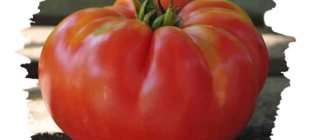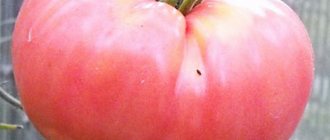The “Fat Jack” tomato is a tomato variety that requires careful care, but can grow even in Siberia when creating a greenhouse effect. If you correctly follow all the points describing the growing process, you will ultimately be able to reap a rich harvest without the need to live in warm parts of the country.
But owners of plots in the southern regions of Russia will receive a pleasant bonus when growing this variety - the tomato can be planted directly in the garden without first creating seedlings.
Description of the variety
The variety has a round but ribbed shape, and when compared with other varieties, you can see that the fruits are slightly flattened. The average weight of one fruit reaches 180 grams, the maximum weight is up to 300 grams (the largest fruits appear only with careful care). The immaturity of the fruit can be determined by the characteristic greenish-light green hue next to the stalk. Ripe tomatoes are colored red, slightly crimson.
The flesh of Fat Jack tomatoes is fleshy, the tomato peel is quite hard, they do not suffer from transportation and can be stored several times longer than other varieties.
The bush of these tomatoes is not tall, the maximum height reaches only 70 centimeters, but the branches can spread out greatly. It is not recommended to remove side shoots, because this plant has very few stepsons and they take up little energy. Pruning should be carried out if more than 4 shoots have grown from one axil - this is extremely rare, but can have a detrimental effect on the growth of the plant.
Reviews from gardeners about this variety of tomatoes are positive, and it is especially praised by lovers of thick, fleshy tomatoes. Fat Jack is most often praised for its sweet flavor and high ripening rate. It is worth noting that gardeners in the Siberian and Ural regions highly appreciated “Fat Jack” because it showed a high level of productivity in the soil.
Due to the fact that the variety began to gain popularity only at the beginning of the 21st century, it is quite difficult to find reviews on the Internet, but based on the characteristics of the variety itself, we can say that the tomato is tasty, with large fruits and dense pulp.
Description and features of agricultural technology, reviews from tomato growers
For planting, use only the seedling method. The age of sprouts for rooting in a permanent bed is 50-60 days from the moment of germination. Place up to 5 bushes per 1 square meter in the ground. m. They do not need formation.
Advice. By pinching the plant down to the 1st fruit cluster, you can achieve the greatest early ripening from the tomato.
The variety has many reviews online. Summer resident Svetlana praised him for the early greenhouse harvest. The woman grew her bushes with 4-5 stems. The fruits reached 200 g and were very tasty. Svetlana (Altai) spoke about the resistance of tomatoes to tomato diseases.
And Andrey from Tomsk region. It was not possible to collect a normal harvest. Its plants stretched up to 1 m and produced a meager amount of fruit. Although the tomatoes themselves corresponded to the declared characteristics. Irina from Tatarstan confirms this thesis.
Judging by the reviews, Fat Jack is really not a very productive tomato. However, he tries to cover this shortcoming with a large number of advantages.
Origin of the variety
The “Fat Jack” tomato was bred by Vladimir Dederko and Olga Postnikova, registered in the first half of the 21st century - in 2014. Registration took place through the “Register of Selection Achievements”.
The register itself contains many specifications of different plant varieties, and as for “Fat Jack” specifically, it was included in the list of varieties “for amateur cultivation in open ground.”
This tells us that the plant does not require academic knowledge to grow, and anyone can provide quality care if they follow the rules described below.
Landing region
If you are going to plant this plant in the southern part of Russia, you can plant it directly in the ground in nature, in a garden bed. Pre-planting of seedlings is not required, although you can play it safe if you are not sure about the soil temperature in your area.
Even if your region is located in the southern part of the country, without using seedlings the ripening time will increase by 5 or 6 days. For other regions, gardeners recommend the standard growing method: in greenhouses and film shelters.
Advantages and disadvantages of the variety
The “Fat Jack” tomato variety was bred for growing on private plots. But given the many advantages, it is also suitable for farms specializing in growing vegetables. The following advantages distinguish “Jack” from other varieties of tomatoes:
- Can be grown in greenhouses, greenhouses or open ground;
- Tomatoes can be planted either in seedlings or without seedlings;
- resistant to minor temperature changes;
- resistant to many diseases;
- high seed germination;
- excellent fruit set in any weather;
- with small bush sizes, excellent yield indicators;
- size and taste of tomatoes;
- does not require special skills and additional hassle during planting and subsequent care;
- precocity;
- excellent presentation;
- tolerates transportation well;
- does not require regular stepsoning;
- wide scope of application;
- It is not a hybrid, which makes it possible to harvest seeds yourself.
Interesting! The maximum concentration of vitamin C in tomatoes is found in the periseminal fluid.
With such a huge number of advantages, “Fat Jack” has practically no disadvantages, except for two:
- the need to form a bush to obtain high yields;
- the need to carry out preventive measures against diseases and pests.
But these disadvantages are so insignificant that growing tomatoes will not cause you serious problems or difficulties.
Ripening time and yield
The germination rate of this variety is very high (from 95% to 99%). The plant will form and mature without additional lighting from garden lamps or fixtures. The more favorable the conditions, the better, but usually the tomato adapts to any conditions, which allows it to be planted in a greenhouse, on open ground, or in a greenhouse.
The first harvest should be expected 100 days after the first germination of the seeds. Another penalty week can be added to this number if the seeds were planted directly into the ground, without preliminary seedlings. If you have a heated greenhouse, the tomato will begin to bear fruit in mid-June, and in open ground - in early July.
How to care?
Experts say that caring for tomatoes is simplified. Some seed manufacturers indicate on the packaging “tomato without hassle.” This is partly true. Water tomatoes infrequently, but keep the soil soft. The seedlings are hilled up and the soil is loosened.
In a fertile bed, seedlings quickly adapt. No fertilizing is used. It is recommended to feed tomatoes for the first time during the formation of the ovary. Magnesium sulfate is injected under the root. You can use the solution “Vermicompost S”; irrigate plants.
If the summer is hot, the pollen may dry out. Fertilization does not occur in the flower. A similar pathology occurs with frequent rains.
If the humidity is high, the pollen sticks together and loses its ability to pollinate. To normalize fertilization in flowers, ovary stimulants are used: “Bud”, “Ovary”, “Epin”.
In order for the fruits to gain weight well, sugars and microelements are concentrated in the pulp, and fertilizing with complex fertilizers is introduced. Choose any mixture that contains as many minerals as possible:
- “Biohumus S”, “Humates +”, superphosphate - use both root and foliar feeding;
- “Agricola - 3”, “Plantafol”, “MagBor”, “Rossa” - prepare a solution for irrigating foliage;
- Vermicompost in the form of a substrate, sapropel, “Springhead”, “Organic Mix” universal fertilizer - sprinkle on bushes;
- Folk remedies - infusion of ash, yeast, nettle, calendula, chamomile.
Fertilizers to increase productivity are introduced once every 3-4 weeks. Fitosporin and Trichodermin are used to prevent infections. Agronomists recommend using “Lipidocid” and “Fitoverm” for insects. Seedlings are treated every 3 weeks.
The Fat Jack variety is in demand among gardeners
Tomatoes always attract attention. I want to try them
The variety is salad, but the fruits are distinguished by their universal use. To keep them for a long time, they are picked at the stage of blanzhe ripeness and left in the basement.
Growing seedlings
By using seedlings, you can play it safe and get a guarantee that the plants will take root. To avoid mistakes in the early stages of creating seedlings and to do everything correctly, follow the instructions:
- It is better to start seedlings in March or April;
- Soak the seeds for 3 hours in a solution of potassium permanganate (a 2% solution is needed). This procedure is required for homemade seeds prepared in advance by the gardener, and if they were purchased in a store, then skip this point;
- Additional point. When you have extra time and you started preparing in advance, you can soak the seeds for 20-24 hours in warm water mixed with a special composition that accelerates plant growth. It is better to consult a local gardening store so as not to overpay and buy a suitable composition;
- Combine picking with fertilizing with fertilizers, which contain a rich set of minerals;
- Depending on where the Fat Jack tomatoes will grow, you need to determine the time of replanting (after the sprouts have sprouted). It should be transplanted into a greenhouse at the beginning of May, into a greenhouse at the end of May, and into open ground in mid-June;
- Remember that after transplanting you will need to feed the tomatoes several more times: once during active flowering and once when fruits are forming.
Characteristics of tomato
A rich harvest and ease of cultivation - these are the parameters that gardeners first look at when choosing a variety. Tomato Fat Jack is in a leading position according to these indicators.
Productivity and fruiting
From one bush you can harvest up to 6 kg of tomatoes per season. This is a fairly high figure, considering that the variety is compact and low-growing, and up to 6 plants can be planted per 1 m² without damaging the harvest.
In central Russia and other regions with a similar climate, when planted using seedlings, Fat Jack tomatoes ripen in about 3 months. In the southern regions, tomatoes are planted directly in open ground. If the spring and summer are fine, they will ripen in almost the same time frame, the maximum difference being 5-7 days.
Studying the description of Fat Jack tomatoes, photos and reviews from gardeners, we can conclude that these tomatoes bear fruit well and ripen in Siberia and more northern latitudes, where they are grown under film cover.
Advice! It is better to combine seedling and non-seedling planting methods, then the tomato harvest will be in 2 waves.
To increase crop yields, you can take a few simple steps:
- During the flowering period, spray 2-3 tomatoes with a weak solution of boric acid (10 g/10 l) - this promotes pollen germination, ovary formation and active fruit growth.
- Once every few days, shake the flowering clusters of tomatoes growing in the greenhouse.
- Tomato beds should be located from east to west (latitude). This will provide more uniform lighting.
- To stimulate root growth, tomatoes should be hilled 2 times: after bulges appear at the base of the trunk and when the color of the lower part of the stem changes from green to bluish.
- Mulch the plantings regularly.
Area of application of fruits
The fruits of Fat Jack tomatoes have a sweet, pronounced tomato taste and aroma. They can be consumed fresh for preparing salads and other cold appetizers. These tomatoes are also used in adjikas, ketchups, pastes, lecho, and squeezed out juice. Fat Jack tomatoes are salted and pickled, after being cut into slices.
Resistance to diseases and pests
According to the description and reviews of Fat Jack tomatoes, the variety is highly resistant to many common nightshade diseases. And yet, preventive treatments of plants will not be superfluous. There have been recorded cases of Fat Jack tomatoes planted in a greenhouse being affected by a pest such as whitefly.
The Colorado potato beetle, mole cricket, spider mite, and slugs also pose a danger to tomato plantings.
Advantages and disadvantages of the variety
The variety is suitable even for beginners. Although it appeared relatively recently, it has already become a favorite among many gardeners. Positive reviews with photos about Fat Jack tomatoes appear online with enviable regularity. The main advantages of these tomatoes:
- high productivity;
- compact bush size;
- large fruits;
- short ripening periods;
- unpretentiousness;
- disease resistance;
- there is no need for stepsoning;
- excellent taste and appearance;
- versatility of use;
- possibility of preparing seeds yourself.
Large fruits of this variety are not suitable for canning in their entirety. Another disadvantage is the need for tying.
Soil preparation
The main condition when planting in open ground is thoroughly heated soil. Sudden frosts, which can occur in spring in different regions of the country, will also not benefit the plant. The soil itself must be loose. Start digging the soil a week before planting.
Caring for bushes is quite simple. This variety does not need to be tied up, unlike the more common varieties in the Russian Federation. Occasionally remove leaves growing on the lower tier to provide ventilation.
Pests and diseases: control and prevention measures
The hybrid is resistant to major diseases and is practically not affected by viruses. However, plants must be protected from fungal infections. Preventive spraying of plantings with phytosporin or another non-toxic biological product will help. Young plants can be treated with a pale pink solution of potassium permanganate. The greenhouse or hotbed must be ventilated frequently and weeds must be removed in a timely manner. It is recommended to periodically inspect the plantings, looking under the leaves.
This will help detect pests. Tomatoes are often affected by aphids, thrips, whiteflies, and naked slugs. Affected plants are treated with insecticides or celandine decoction.
The tomato variety “Ivanych” F1 is a successful hybrid that has been tested in different regions. If you follow the simplest care requirements, the result is excellent; the tomato pleases with its yield and excellent taste of the fruit.
In the table below you will find links to tomato varieties with different ripening periods:
| Mid-season | Mid-late | Late ripening |
| Gina | Abakan pink | Bobcat |
| Ox ears | French grape | Russian size |
| Roma f1 | Yellow banana | King of Kings |
| Black Prince | Titanium | Long Keeper |
| Lorraine beauty | Slot f1 | Grandma's gift |
| Stellate sturgeon | Volgogradsky 5 95 | Podsinsky miracle |
| Intuition | Krasnobay f1 | Brown sugar |
Bush care
Basic steps for caring for Fat Jack tomatoes:
- Regular watering with warm, settled water (preferably in the evening);
- Loosening the soil in the beds;
- Weeding and weed removal;
- Feeding plants with organic matter and mineral complexes.
The following substances can be used as fertilizers:
- Banana peel;
- Boric acid;
- Hydrogen peroxide;
- Yeast;
- Ash;
- Iodine;
- Ammonia.
Fat Jack tomatoes on video
If you have grown Fat Jack tomatoes, please write down whether you liked them or not. What was the yield and taste of the fruits in your climatic conditions? Has this variety become your favorite? How do you rate the disease resistance of this tomato? Briefly describe the advantages and disadvantages of this tomato in your opinion. If possible, attach to the comment a photo of the entire bush as a whole or individual fruits that you grew. Thank you!
Your reviews of the Fat Jack tomato and additions to the description will help many gardeners evaluate this variety more objectively and decide whether it is worth planting or not.
This is a natural variety of tomato. Therefore, we recommend taking seeds from a ripe fruit and growing them again next season!
Rules for planting and subsequent care
The “Fat Jack” tomato variety is recommended for growing in greenhouses, open ground and greenhouses. Accordingly, there are two methods of cultivation - seedlings and non-seedlings.
But whatever method you choose, you can be sure that with minimal physical effort you will get a bountiful harvest of aromatic and extremely tasty tomatoes.
Watering and weeding
It is necessary to moisten the soil after the top layer of soil has completely dried. You can feed tomatoes during the period of flowering and fruit formation. For this, it is recommended to use complex mineral fertilizers.
Fat Jack tomatoes are my favorite determinate variety.
Tomato variety FAT JACK
October 10, 2021 Fat Jack!! We tried super tomatoes this year, they just hang in bunches, and so many more!!!
It is imperative to remove weeds around the bushes, they can cause diseases. Preventive measures to protect tomatoes from diseases and pests are the same as for all other types.
Tomato Fat Jack: reviews, photos, yield
Easy care and high productivity - these are the requirements that summer residents place on early varieties of tomatoes.
Thanks to breeders, gardeners have a very large selection of different varieties, from classic varieties to new hybrids. Among this diversity, it is difficult to find one that can rightfully be called universal in all respects. After all, it is not enough to grow a tomato; it is important that it has excellent taste and a wide range of applications. In all of the above parameters, the Fat Jack tomato is in many ways superior to its counterparts. What is unique about this variety, what are its main characteristics? Is it really unpretentious and high-yielding? You will find answers to all questions in this article.
The Fat Jack tomato has already been appreciated by many farmers and summer residents. And this variety deserves special attention. The variety was developed relatively recently. It was registered in the State Register only in 2014.
Tomato seeds have a very high germination rate (98-99%). Growing seedlings does not require the use of special skills and equipment. Plants sprout and grow well without lighting.
“Fat Jack,” according to the stated characteristics, is suitable for cultivation either in open ground, or in greenhouses, or in greenhouses. It belongs to the early varieties, since the first harvest of tomatoes can be harvested within 95-105 days after active seed germination.
When tomatoes are grown in heated greenhouses, they begin to bear fruit in early to mid-June. In open ground, fruiting begins 2-3 weeks later, which indicates its early ripening.
Interesting! When growing Fat Jack tomatoes in open ground using the seedless method, the ripening period increases by 7-10 days.
By planting some plants in a greenhouse and some in open ground, you can extend the fruiting period and get a harvest of tasty tomatoes over a longer period.
Planting "Fat Jack" tomato seeds directly into open ground is possible only in southern regions with a warm climate. But in the central and northern regions, it is recommended to grow tomatoes in seedlings. But a tomato lover from Siberia grows “Fat Jack” by planting the seeds directly in the beds, and in harsh climate conditions he gets an excellent harvest.
Tomato bushes are low. Reach no more than 40-60 cm in height, spreading. The foliage is average, the color and shape of the foliage are standard.
The "Fat Jack" tomato does not require regular pruning. But this condition should be observed only if you have already formed a bush of 3-4 stems.
The Fat Jack tomato is a determinate variety. The fruits have a classic bright red color, the shape of the tomatoes is round-flat.
Like all low-growing plants, tomatoes of this variety require timely removal of the lower leaves to improve aeration of the root part of the plant and prevent root rot.
Tomatoes do not need a mandatory garter. But given the number and size of the fruits, it is still worth tying the plants to a support to avoid breaking off the clusters.
Interesting! “Fat Jack” is so unpretentious that it can be grown even in winter on an insulated loggia.
A brief description and characteristics of the “Fat Jack” tomato fruit comes down to the following parameters:
- Round-flat shape;
- Bright red color;
- Average weight 250-350 grams;
- The pulp is dense, aromatic, sweet;
- Universal tomatoes.
Among other things, tomatoes are distinguished by their high yield - up to 6 kg per bush - with a rather modest size.
Those gardeners who have already planted tomatoes of this variety note that the tomatoes have a sweet, rich tomato taste with a barely noticeable sourness. The fruits ripen in waves, which gives housewives the opportunity to process the harvested crop without difficulty and unnecessary haste.
The “Fat Jack” tomato variety was bred for growing on private plots. But given the many advantages, it is also suitable for farms specializing in growing vegetables. The following advantages distinguish “Jack” from other varieties of tomatoes:
- Can be grown in greenhouses, greenhouses or open ground;
- Tomatoes can be planted either in seedlings or without seedlings;
- resistant to minor temperature changes;
- resistant to many diseases;
- high seed germination;
- excellent fruit set in any weather;
- with small bush sizes, excellent yield indicators;
- size and taste of tomatoes;
- does not require special skills and additional hassle during planting and subsequent care;
- precocity;
- excellent presentation;
- tolerates transportation well;
- does not require regular stepsoning;
- wide scope of application;
- It is not a hybrid, which makes it possible to harvest seeds yourself.
Interesting! The maximum concentration of vitamin C in tomatoes is found in the periseminal fluid.
With such a huge number of advantages, “Fat Jack” has practically no disadvantages, except for two:
- the need to form a bush to obtain high yields;
- the need to carry out preventive measures against diseases and pests.
But these disadvantages are so insignificant that growing tomatoes will not cause you serious problems or difficulties.
Initially, the Fat Jack tomato was bred as a salad variety. That is, its fruits are suitable mainly for cutting into summer salads and eating fresh. But those gardeners who planted tomatoes on their plot and managed to evaluate the quality of tomatoes speak of it as a universal-purpose tomato. Tomatoes can be used in almost any area:
- for preparing tomato juices and pastes;
- preparing various sauces, ketchups and adjika;
- as a component in the process of preparing a variety of dishes, casseroles and baked goods;
- for whole-fruit canning;
- for winter preparations - salads, lecho, solyanka.
Housewives who are actively preparing a generous harvest for the winter also use tomatoes for quick freezing in sliced form or for drying. Subsequently, these preparations are added to the first and second courses during the cooking process.
It is worth noting that during the preservation process, tomatoes do not lose their excellent taste. Fruits do not crack when canned whole fruit.
Interesting! Few people know that the pulp of ripe tomatoes can be used to treat burns and abrasions, but green ones can treat varicose veins.
The “Fat Jack” tomato variety is recommended for growing in greenhouses, open ground and greenhouses. Accordingly, there are two methods of cultivation - seedlings and non-seedlings.
But whatever method you choose, you can be sure that with minimal physical effort you will get a bountiful harvest of aromatic and extremely tasty tomatoes.
Growing Fat Jack tomatoes is no more difficult than regular tomato varieties. Self-harvested seeds must be soaked for 2-3 hours in a 2% solution of potassium permanganate (pink color). Purchased seed material does not require such processing.
If you wish, you can soak the seeds for a day in warm water with the addition of any composition that stimulates the formation and growth of the root system. But even without this event, tomatoes sprout quickly and amicably.
Seeds for seedlings should be sown in late March - early April. Picking should be done in the phase of 2-3 well-formed leaves, combining it with the first fertilizing with mineral fertilizers.
You need to replant seedlings:
- in the greenhouse at the end of April - beginning of May;
- in the greenhouse in mid-late May;
- in open ground in early - mid-June.
Many summer residents add crushed eggshells to each hole when transplanting tomatoes. But this type of feeding is completely useless. Yes, eggshells are rich in calcium and minerals, but at the time of active growth of green mass, the plant needs nitrogen.
Moreover, before fertilizing the soil with shells, they must be washed, dried and literally ground into dust. Whether the effort is worth it, and whether there is a result from these actions, is a moot point.
Interesting! Potassium and magnesium are found in large quantities in ripe tomatoes.
After transplantation, tomatoes need to be fed twice: during active flowering and fruit formation.
Despite the fact that “Fat Jack” does not require a garter, it is still recommended to tie the plants to a support - not every bush can withstand a load of 5-6 kg.
Bushes need to be formed into 3-4 stems. After formation, the stepsons do not grow so actively, so you only need to remove excess side shoots from time to time so that all the forces and nutrients are directed to the formation, growth and ripening of the fruits.
Growing tomatoes without seedlings
You can plant Fat Jack tomato seeds in open ground as early as mid-to-late May. The main condition is sufficiently well-warmed soil and no threat of possible spring frosts.
The area for planting tomatoes should be sufficiently illuminated, and the soil should be loose and fertile. You need to dig up the ground in advance, 7-10 days before the proposed planting.
Immediately after planting, the beds should be watered generously with warm, settled water and covered with any non-woven covering material or film. Open the beds during warm, sunny weather, and be sure to close the beds at night.
After 2-3 weeks, you need to thin out the seedlings and feed the tomatoes with complex mineral fertilizers.
Subsequent care of plants consists of the usual activities for any gardener:
- weeding;
- watering;
- loosening;
- bush formation;
- removal of stepsons;
- feeding
The recommended planting scheme is 5-6 plants per 1 m². When growing tomatoes in beds, the distance between plants should be at least 35-40 cm.
Interesting! In Russia, tomatoes appeared at the end of the 18th century and were called “mad berries” or “dogs”.
It should be remembered that when growing Fat Jack tomatoes in open ground, the tomatoes ripen a week to a week and a half later than in a greenhouse.
To prevent root rot, be sure to remove the lower leaves to ensure sufficient air exchange. And one more recommendation - remove weeds from the site so that they do not cause diseases in the tomatoes.
Tomatoes are highly resistant to many diseases. But you should not forget about preventive treatments against diseases and pests.
If you follow the recommendations for planting and subsequent care, “Fat Jack” tomatoes produce a bountiful harvest even when grown in open ground using the seedless method. Residents of the Siberian and Ural regions, whose climatic conditions are famous for the late arrival of spring and late returning spring frosts, appreciated this variety.
The author of the video shares his impressions of the “Fat Jack” tomato variety, its cultivation, and also gives a brief description of its fruits
The characteristics and descriptions of the “Fat Jack” tomato variety, as well as numerous reviews from amateur gardeners and gardeners, indicate that it is worth growing at least a few bushes on your plot as an experiment. Perhaps you will like the taste of tomatoes, and it will take its rightful place on your list of must-plant varieties.
This is the second year I've been planting Fat Jack. A neighbor shared the seeds with me. By nature, I really like to experiment. I planted seedlings and then planted them in open ground. At first, my tomatoes stood under the covering material for 2-3 weeks, and in mid-August I began to cover them - autumn is coming early here. Productivity was high. I collected about a bucket from each bush. In the first year there was not enough for preparations, so I cannot evaluate it in the culinary field. And this year I rolled up several jars of whole tomatoes and made lecho. They look beautiful in jars and did not crack when poured with boiling water. I don’t really like new varieties and prefer to plant only my favorites. But this year the store didn’t have my favorite variety “Sanka” and, on the advice of the seller, I took “Fat Jack”. I must say that I really liked these tomatoes. A little larger than Sanka, but very tasty, meaty and sweet. Just as I wanted, low bushes and early ripening. I even rolled up a few cans of juice to try, but I still don’t know what it tastes like. I collected the seeds and will plant more next year.











